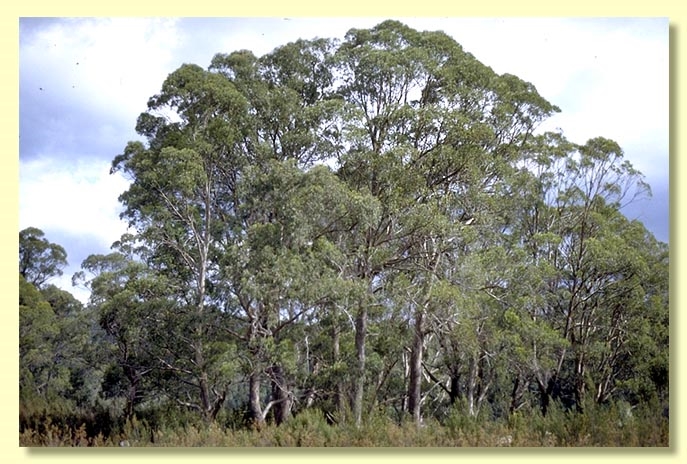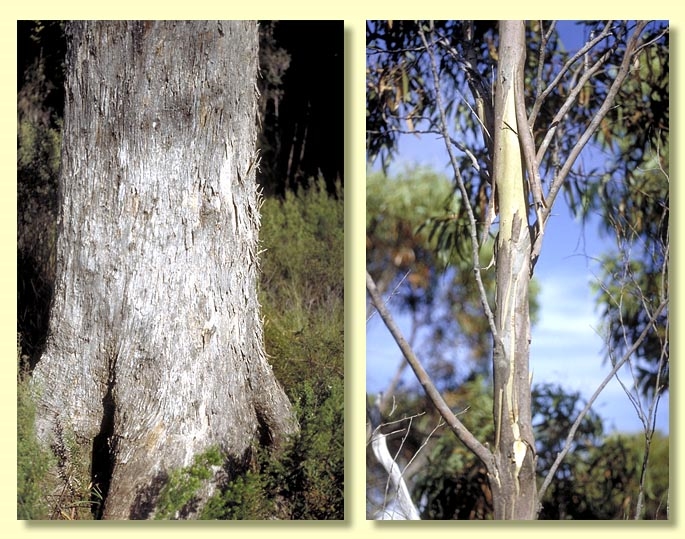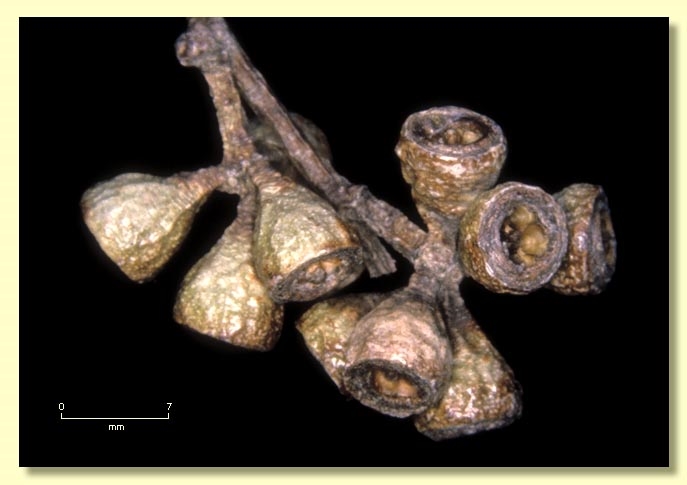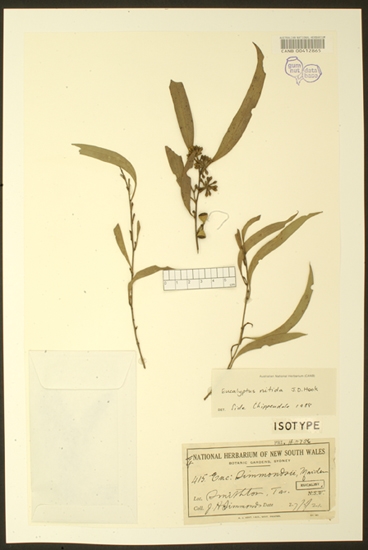Euclid - Online edition
Eucalyptus nitida
Eucalyptus | Eucalyptus | Aromatica | Insulanae
Eucalyptus nitida Hook. f., Fl. Tasman. 1: 137, t. 29 (1856).
Eucalyptus amygdalina var. nitida (Hook. f.) Benth., Fl. Austral. 3: 203 (1867); E. australiana var. nitida (Hook. f.) Ewart, Fl. Victoria 833 (1931). T: ?Circular Head, Tas., 21 Jan. 1837, R.Gunn 808; holo: K; iso: BM, NSW.
Eucalyptus simmondsii Maiden, Crit. Revis. Eucalyptus 6: 344 (1922). T: Smithton, beyond Burnie, Tas., 27 May 1921, J.H.Simmonds, s.n.; holo: NSW; iso: CANB.
Eucalyptus ambigua DC., Prodromus Systematis Naturalis Regni Vegetabilis 3: 219 (1828). T: New Holland [south-eastern Tasmania], undated [1792 or 1793], J.J.H. Labillardière. Lecto: G-DC sheet G00131709 [image at BRI], fide A.R.Bean, Muelleria 27: 227-229 (2009).
Bean (2009) regards E. ambigua DC. as the correct name for the taxon known as Eucalyptus nitida Hook.f. in Tasmania. However, M.F.Duretto suggested in 2010, as cited by Australian Plant Census (http://www.anbg.gov.au/cgi-bin/apclist), that the type material of E. nitida is not conspecific with that of E. ambigua and its placement is currently uncertain. This difference of opinion is unresolved and EUCLID follows the practice of the Tasmanian Herbarium (HO) and continues to use the name Eucalyptus nitida Hook.
Bark rough on trunk and limbs of larger trees, and on base of stems in small trees and mallees, loosely woven peppermint-type, grey, trunks of small trees or mallees sometimes entirely smooth-barked; smooth bark cream to grey-green, yellow-grey or pink-brown, scribbles present; crowns often with long ribbons of bark incompletely shed from branches.
Juvenile growth (coppice or field seedlings to 50 cm): stem rounded in cross-section, conspicuously warty; juvenile leaves opposite and sessile for many nodes (0.8–1.2 m tall), lanceolate to elliptical, 4.5–8.5 cm long, 1–3 cm wide, stem-clasping, lowest leaves discolorous with margin slightly denticulate and midrib underneath scabrid, upper leaves concolorous, green, not scabrid.
Adult leaves alternate, petiole 0.4–1.7 cm long; blade lanceolate to falcate, 5.5–13 cm long, 0.6–1.7 cm wide, base tapering to petiole, concolorous, glossy, green, side-veins acute, reticulation sparse or absent, intramarginal vein parallel to and remote from margin, oil glands island.
Inflorescence axillary unbranched, peduncles 0.2–0.9 cm long, buds 9 to ?15 per umbel, pedicels 0.1–0.6 cm long. Mature buds clavate, 0.3–0.5 cm long, 0.3–0.4 cm wide, green, scar absent, operculum rounded to conical (often narrower than the hypanthium), stamens mostly inflexed, anthers reniform to cordate, versatile, dorsifixed, dehiscing by confluent slits, style often short, stigma tapered, locules 3 or 4, the placentae each with 2 vertical ovule rows. Flowers white.
Fruit pedicels 0–0.4 cm long, cup-shaped to hemispherical or obconical, 0.4–0.8 cm long, 0.5–0.9 cm wide, disc raised or level, valves 3 or 4, near rim level or enclosed.
Seeds brown, 1–1.8 mm long, pyramidal or obliquely pyramidal, dorsal surface smooth, hilum terminal.
Cultivated seedlings (measured at ca node 10): cotyledons reniform; stems square in cross-section, warty; leaves sessile and opposite for many nodes, cordate to lanceolate-elliptic, 4.5–8.5 cm long, 0.8–4 cm wide, base amplexicaul or truncate to rounded or tapering, margin denticulate, apex pointed, concolorous, dull, green.
Flowering has been recorded in January, November and December.
A small to tall tree widespread in western and southern Tasmania, forming mallees on sand dunes in some coastal areas. Populations in north coastal Tasmania and from Flinders Island belong to this species. Bark is rough over part or whole of trunk, rarely smooth throughout.
E. nitida differs from the other dominant peppermint in Tasmania, E. amygdalina, which has a north-eastern distribution, in having slightly broader crown leaves and lanceolate-elliptical juvenile leaves >1 cm wide (juvenile leaves <1.1 cm wide in E. amygdalina ), while E. pulchella, confined to south-eastern Tasmania is completely smooth-barked or rough only towards the base and has much narrower, linear leaves.
Eucalyptus nitida belongs to Eucalyptus subgenus Eucalyptus section Aromatica (the peppermints) because the buds have a single operculum, anthers are reniform, ovules are in two rows, seeds are more or less pyramidal, adult leaf venation is acute and juvenile leaves are sessile and opposite for many pairs. Within this section, E. nitida belongs to an endemic Tasmanian series of seven species, series Insulanae, with the other species being E. pulchella and E. amygdalina, mentioned above; E. tenuiramis, a smooth-barked tree with glaucous branchlets and a crown of mixed alternate, petiolate, adult leaves and opposite, petiolate, intermediate leaves; E. risdonii, also smooth-barked but with a glaucous crown of opposite, sessile, often connate juvenile leaves; and E. coccifera, a smooth-barked species of cold, high areas, with glaucous branchlets and elliptical to cordate (non-connate) juvenile leaves, a crown of fully adult, elliptical to lanceolate leaves and warty buds in clusters of three, seven or nine. (The other species have buds in clusters of nine or more.) In 2008 Alan Gray described E. nebulosa a small growing smooth-barked peppermint species from serpentine ridges. It has an overall greyish cast to the crown and has waxy branchlets, juvenile leaves which are shortly elliptical, about 2 to 3 times as long as wide and 2.5-4.5 cm long, greyish blue. Buds are similar to E. nitida but on shorter pedicels. Fruit are also similar but a bit smaller (ca 0.3–0.6 cm wide). .
The only other peppermint species found in Tasmania (apart from the above) is the more distantly related, common mainland species, E. radiata subsp. radiata, a rough-barked, tall forest tree restricted, in Tasmania, to the Lemonthyne area. It has a narrow-leaved crown of adult leaves and lanceolate juvenile leaves with numerous oil glands.
The Victorian and South Australian species Eucalyptus willisii was split off from E. nitida (Ladiges et al 1983); however, populations of the former at its type locality on Wilsons Promontory seem to differ somewhat from other Victorian populations, especially those around Longford and Holey Plains, and indeed show strong similarity with E. nitida.
















